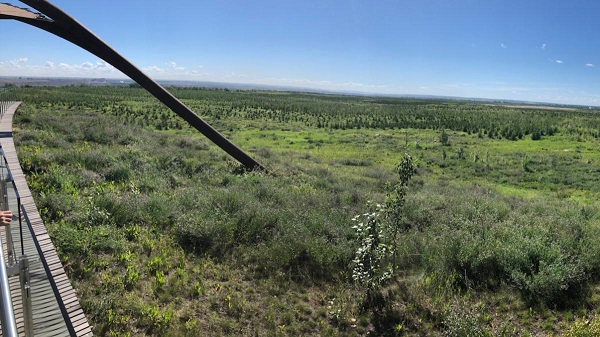Environment
Trump rejects key conclusion of US government climate report

WASHINGTON — President Donald Trump has rejected a central conclusion of a dire report on the economic costs of climate change released by his own administration, but economists said the warning of hundreds of billions of dollars a year in global warming costs is pretty much on the money.
Just look at last year with Hurricanes Harvey, Maria and Irma, they said. Those three 2017 storms caused at least $265 billion in damage , according to the National Oceanic and Atmospheric Administration.
The National Climate Assessment report , quietly unveiled Friday, warned that natural disasters are worsening in the United States because of global warming.
It said warming-charged extremes “have already become more frequent, intense, widespread or of long duration.” The report noted the last few years have smashed U.S. records for damaging weather, costing nearly $400 billion since 2015.
“The potential for losses in some sectors could reach hundreds of billions of dollars per year by the end of this century,” the report said. It added that if emissions of heat-trapping gases continue at current levels,
The president said he read some of the report “and it’s fine” but not the part about the devastating economic impact.
“I don’t believe it,” Trump said, adding that if “every other place on Earth is dirty, that’s not so good.”
Nearly every country in the world in 2015 pledged to reduce or slow the growth of carbon dioxide emissions, the chief greenhouse gas.
“We’re already there,” said Wesleyan University economist Gary Yohe, who was a reviewer of the national report, which was produced by 13 federal agencies and outside scientists. “Climate change is making a noticeable impact on our economy right now: Harvey, Florence, Michael, Maria.”
Yohe said, “It is devastating at particular locations, but for the entire country? No.”
Economist Ray Kopp, a
“I believe this is going to be a devastating loss without any other action-taking place,” Kopp said Monday. “This is certainly something you would want to avoid.”
Earlier, the White House had played down the report. Spokeswoman Lindsay Walters said in an emailed statement that the report “is largely based on the most extreme scenario, which contradicts long-established trends by assuming that, despite strong economic growth that would increase greenhouse gas emissions, there would be limited technology and innovation, and a rapidly expanding population. “
Throughout the 29-chapter report, scientists provide three scenarios that the United Nations’ climate assessments use. One is the business-as-usual scenario, which scientists say is closest to the current situation. That is the worst case of the three scenarios. Another would envision modest reductions in heat-trapping gases, and the third would involve severe cuts in carbon dioxide pollution.
For example, the $155 billion a year in extra
The report talks of hundreds of billions of dollars in economic losses in several spots. In one graphic, it shows the worst-case business-as-usual scenario of economic costs reaching 10
Yohe said it was unfortunate that some media jumped on that 10
“The 10
Kopp, on the other hand, said the 10
“This is probably a best estimate,” Kopp said. “It could be larger. It could be smaller.”
___
Associated Press writer Jonathan Lemire in New York contributed to this report.
___
Follow Seth Borenstein at http://twitter.com/borenbears and Zeke Miller at http://twitter.com/zekejmiller
Seth Borenstein And Zeke Miller, The Associated Press
Energy
B.C. Residents File Competition Bureau Complaint Against David Suzuki Foundation for Use of False Imagery in Anti-Energy Campaigns

From Energy Now and The Canadian Newswire
A group of eight residents of Northeast British Columbia have filed a formal application for inquiry with Canada’s Competition Bureau, calling for an investigation into the David Suzuki Foundation’s (the Foundation) use of false and misleading imagery in its anti-energy campaigns.
The complaint alleges that the Foundation has repeatedly used a two-decade-old aerial photograph of Wyoming gas wells to falsely depict modern natural gas development in B.C.’s Montney Formation. This area produces roughly half of Canada’s natural gas.
Key Facts:
- The misleading image has been used on the Foundation’s website, social media pages, reports and donation appeals.
- The Foundation has acknowledged the image’s true source (Wyoming) in some contexts but has continued to use it to represent B.C. development.
- The residents claim this materially misleads donors and the public, violating Section 74.01(1) of the Competition Act.
- The complaint is filed under Sections 9 and 10 of the Act, asking the Bureau to investigate and impose remedies including ceasing the conduct, publishing corrective notices, and returning proceeds.
Quote from Deena Del Giusto, Spokesperson:
“This is about fairness and truth. The people of Northeast B.C. are proud of the work they do to produce energy for Canada and the world. They deserve honest debate, not scare tactics and misleading imagery used to raise millions in donations. We’re asking the Competition Bureau to hold the David Suzuki Foundation to the same standard businesses face: tell the truth.”
Background:
Natural gas development in the Montney Formation supports thousands of jobs and fuels economic activity across the region. Accurate public information is vital to informed debate, especially as many Canadians live far from production sites.
SOURCE Deena Del Giusto
Canadian Energy Centre
Alberta oil sands legacy tailings down 40 per cent since 2015

Wapisiw Lookout, reclaimed site of the oil sands industry’s first tailings pond, which started in 1967. The area was restored to a solid surface in 2010 and now functions as a 220-acre watershed. Photo courtesy Suncor Energy
From the Canadian Energy Centre
By CEC Research
Mines demonstrate significant strides through technological innovation
Tailings are a byproduct of mining operations around the world.
In Alberta’s oil sands, tailings are a fluid mixture of water, sand, silt, clay and residual bitumen generated during the extraction process.
Engineered basins or “tailings ponds” store the material and help oil sands mining projects recycle water, reducing the amount withdrawn from the Athabasca River.
In 2023, 79 per cent of the water used for oil sands mining was recycled, according to the latest data from the Alberta Energy Regulator (AER).
Decades of operations, rising production and federal regulations prohibiting the release of process-affected water have contributed to a significant accumulation of oil sands fluid tailings.
The Mining Association of Canada describes that:
“Like many other industrial processes, the oil sands mining process requires water.
However, while many other types of mines in Canada like copper, nickel, gold, iron ore and diamond mines are allowed to release water (effluent) to an aquatic environment provided that it meets stringent regulatory requirements, there are no such regulations for oil sands mines.
Instead, these mines have had to retain most of the water used in their processes, and significant amounts of accumulated precipitation, since the mines began operating.”
Despite this ongoing challenge, oil sands mining operators have made significant strides in reducing fluid tailings through technological innovation.
This is demonstrated by reductions in “legacy fluid tailings” since 2015.
Legacy Fluid Tailings vs. New Fluid Tailings
As part of implementing the Tailings Management Framework introduced in March 2015, the AER released Directive 085: Fluid Tailings Management for Oil Sands Mining Projects in July 2016.
Directive 085 introduced new criteria for the measurement and closure of “legacy fluid tailings” separate from those applied to “new fluid tailings.”
Legacy fluid tailings are defined as those deposited in storage before January 1, 2015, while new fluid tailings are those deposited in storage after January 1, 2015.
The new rules specified that new fluid tailings must be ready to reclaim ten years after the end of a mine’s life, while legacy fluid tailings must be ready to reclaim by the end of a mine’s life.
Total Oil Sands Legacy Fluid Tailings
Alberta’s oil sands mining sector decreased total legacy fluid tailings by approximately 40 per cent between 2015 and 2024, according to the latest company reporting to the AER.
Total legacy fluid tailings in 2024 were approximately 623 million cubic metres, down from about one billion cubic metres in 2015.
The reductions are led by the sector’s longest-running projects: Suncor Energy’s Base Mine (opened in 1967), Syncrude’s Mildred Lake Mine (opened in 1978), and Syncrude’s Aurora North Mine (opened in 2001). All are now operated by Suncor Energy.
The Horizon Mine, operated by Canadian Natural Resources (opened in 2009) also reports a significant reduction in legacy fluid tailings.
The Muskeg River Mine (opened in 2002) and Jackpine Mine (opened in 2010) had modest changes in legacy fluid tailings over the period. Both are now operated by Canadian Natural Resources.
Imperial Oil’s Kearl Mine (opened in 2013) and Suncor Energy’s Fort Hills Mine (opened in 2018) have no reported legacy fluid tailings.
Suncor Energy Base Mine
Between 2015 and 2024, Suncor Energy’s Base Mine reduced legacy fluid tailings by approximately 98 per cent, from 293 million cubic metres to 6 million cubic metres.
Syncrude Mildred Lake Mine
Between 2015 and 2024, Syncrude’s Mildred Lake Mine reduced legacy fluid tailings by approximately 15 per cent, from 457 million cubic metres to 389 million cubic metres.
Syncrude Aurora North Mine
Between 2015 and 2024, Syncrude’s Aurora North Mine reduced legacy fluid tailings by approximately 25 per cent, from 102 million cubic metres to 77 million cubic metres.
Canadian Natural Resources Horizon Mine
Between 2015 and 2024, Canadian Natural Resources’ Horizon Mine reduced legacy fluid tailings by approximately 36 per cent, from 66 million cubic metres to 42 million cubic metres.
Total Oil Sands Fluid Tailings
Reducing legacy fluid tailings has helped slow the overall growth of fluid tailings across the oil sands sector.
Without efforts to reduce legacy fluid tailings, the total oil sands fluid tailings footprint today would be approximately 1.6 billion cubic metres.
The current fluid tailings volume stands at approximately 1.2 billion cubic metres, up from roughly 1.1 billion in 2015.
The unaltered reproduction of this content is free of charge with attribution to the Canadian Energy Centre.
-

 Daily Caller18 hours ago
Daily Caller18 hours agoTrump’s One Big Beautiful Bill Resets The Energy Policy Playing Field
-

 Agriculture1 day ago
Agriculture1 day agoLacombe meat processor scores $1.2 million dollar provincial tax credit to help expansion
-

 conflict2 days ago
conflict2 days agoUS airstrike on Iran’s nuclear facilities. Was it obliteration?
-

 Crime1 day ago
Crime1 day agoThe Left Thinks Drug Criminalization Is Racist. Minorities Disagree
-

 Business1 day ago
Business1 day agoDallas mayor invites NYers to first ‘sanctuary city from socialism’
-

 Alberta Sports Hall of Fame and Museum1 day ago
Alberta Sports Hall of Fame and Museum1 day agoAlberta Sports Hall of Fame 2025 Inductee profiles – Alpine Skiing Athlete – Brady Leman
-

 Business9 hours ago
Business9 hours agoThe Digital Services Tax Q&A: “It was going to be complicated and messy”
-

 Carbon Tax19 hours ago
Carbon Tax19 hours agoCanada’s Carbon Tax Is A Disaster For Our Economy And Oil Industry











